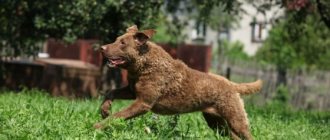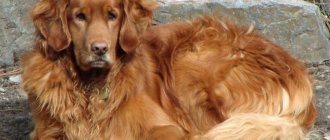Tollers are devoted to only one person, the leader of the pack. But they are also loyal to other family members. Another distinguishing feature is intelligence. Among the disadvantages are impatience of loneliness, exposure to stress, and severe shedding.
Origin story
As a breed, the Nova Scotia Retriever developed in the early 19th century in the Little River Harbor Community of Yarmouth, Nova Scotia, Canada. It was originally known locally as the Little River Duck Dog or Yarmouth Toller.
The author of works on the history of Canadian dogs dating back to the 18th century, Nicholas Denis, does not deny that small red retrievers could have been brought from the Old World to the Eastern Province of Canada. But it is also likely that the breed developed here in Nova Scotia from several other European breeds. The toller's ancestors could have been Bretons, golden retrievers, spaniels, Irish setters and herding dogs of the border collie type.
In the 17th to 19th centuries, red duck dogs were widespread on the East Coast of Canada. The breed was officially recognized by the Canadian Kennel Club in 1945. The Fédération Cynologique Internationale (FCI) recognized the breed in 1987.
Hunting with a Nova Scotia Retriever calling in ducks
Already by the name, it becomes clear that these dogs can not only bring wounded animals from land or water, but are also capable of luring ducks, which is undoubtedly a unique talent.
The Nova Scotia Retriever works on the same principle as the red fox. He runs along the shore and actively waves his tail. Ducks flock to these movements as if spellbound. On paper this style of hunting seems absurd, but in life it really works.
The hunter hides not far from the shore and throws a stick or ball to the dog. She runs along the pond in search of a toy and creates a fuss. At this time, attracted by the noise and movement of the fluffy red tail, the ducks swim towards the shore as if hypnotized. After a series of successful shots from the hidden hunter, the toller, as befits a true retriever, retrieves the bird from the water. It is worth noting that these dogs adore water, swim very well, can dive, and are ready to work day and night, at any time of the year, until the water is covered with ice. The webbed paws facilitate rapid movement in the water, and the dense undercoat protects against hypothermia.
In most countries of the world, Tollers are used exclusively as retrievers, but among hunters there are true connoisseurs of the breed who, with the help of a dog, lure birds.
Video about the dog breed Nova Scotia Retriever (Toller):
Historical reference
Tollers appeared in Scotland, hence their name - Nova Scotia Retriever . It was first mentioned in the XYII century. However, the route of its entry into Europe is not truly known.
Although many dog experts believe that this breed is the heir of the kooikerhondje, to which tollers are similar both visually and in behavior.
Kooikerhondje To a certain extent, shelties, cocker spaniels and Irish setters were involved in the development of the breed.
Despite the fact that Tollers have a European origin, the fundamental selection took place on the American mainland, where the breed was called the “Little River Duck Dog.”
By the mid-forties of the last century, the Toller was recognized in the Canadian dog breeding society, at the same time Nova Scotia retrievers returned to European territory and began to actively disperse in England and the Scandinavian countries. And in 1987, the initial breed standard was adopted.
Did you know? Dogs hate hugging - they perceive it as a sign of dominance.
Breed characteristics and character
An alternative name for the Nova Scotia Retriever breed is Toller. Its history goes back several centuries, and the first mentions date back to the 17th century, when dogs were first brought from European countries to Canada and the States.
The retriever's relatives include collies, spaniels, setters, and shelties. By the way, another name for the breed is the Little River duck dog, or, more simply put, Nova Scotia duck retriever . It is associated with the place of Yarmouth (Nova Scotia), where these dogs began to be actively bred.
After the war, the animals returned to Europe, and today they are most common in Britain and Scandinavia. In Russia you can hardly find this breed. Accordingly, the price for these dogs is high. The main function is hunting.
This instinct is well developed in them. If you don't let your dog hunt, he will become apathetic and lethargic. In addition to this function, duck retrievers are considered good companions and are also famous for their guarding abilities.
Advantages and disadvantages
Every breed has its own advantages and disadvantages. Advantages of the Nova Scotia Retriever:
- hunting instincts are well developed;
- good-natured character;
- highly developed intelligence;
- devotion to the owner;
- resistance to temperature changes in the external environment;
- activity and energy;
- neatness towards children.
Duck Hunter
The shortcomings of a particular dog are often caused by improper upbringing. But most often owners complain about the following disadvantages:
- hyperactivity;
- exposure to stress;
- intolerance of loneliness;
- severe shedding;
- the need for long active walks;
- absent-mindedness.
Choosing a dog is a responsible matter. You need to understand for what purpose the pet is purchased.
Kinds
The Nova Scotia Toller Retriever belongs to the group of hunting dogs whose task is to find and bring a shot bird to its owner. High intelligence, endurance, and versatility in use unite duck representatives with other varieties of retrievers. In total, according to FCI parameters, 6 species are distinguished, including the “duck” hunter:
- Labradors;
- Nova Scotia Retrievers;
- straight-haired;
- Chesapeake Bay;
- golden;
- curly-haired.
The work of Canadian hunters on the breed brought recognition to the Nova Scotia Toller on an equal basis with its larger relatives. Sometimes the “duck” representative is confused with the golden retriever, which has a very gentle disposition that makes it possible to make guide dogs out of them.
Advantages and disadvantages
Toller is a dog that has its pros and cons. This is a very smart and quick-witted breed. They are devoted to their owners and are always ready to actively protect them. Retrievers are excellent hunters and, thanks to their unique double coat, can withstand low temperatures.
The disadvantages of the breed include:
- Tollers absolutely cannot stand loneliness;
- severe shedding, requiring regular brushing;
- the need for long walks and physical activity.
Important ! You only need to walk your Canadian Retriever on a leash, as the pet gets carried away very quickly and can run away.
Toller is a loyal and devoted friend with an affectionate character
Description of the breed (requirements for the standard)
These are medium-sized dogs, but among retrievers the Toller is considered small in size, because the height of adult individuals is only about half a meter. A dog of this breed has strong bones; quite powerful, albeit compact, physique, not weak muscles. The ideal weight for males is 20 kg or slightly more. Female individuals may have a couple of kilograms less.
Dogs of this breed have a lot of advantages, but they are not suitable for all owners. They are smart, even to some extent intelligent, in addition, they are perky, playful, and resilient.
But these character traits impose a huge responsibility on the owner, who is obliged to bestow caring patience on the pet, paying due attention to its upbringing. A puppy should be taught various commands from the age of six months, with parental persistence.
According to the standard, all the characteristics that give purebred representatives are aimed at fulfilling their hunting functions. Tollers have a wedge-shaped head with a wide and strong rounded forehead, narrowed three times at the transition to the nose.
How to choose a puppy?
Finding a good breeder of this breed is difficult because it is rare. On average, the cost varies between 55-90 thousand rubles.
When choosing a puppy, you need to pay attention to the main features that characterize the breed:
- developed neck and chest;
- straight back and graceful stance;
- active tail, wide at the base and narrow at the end;
- wedge-shaped skull with an elongated muzzle;
- medium-sized triangular ears;
- chocolate cream color with white spots;
- smooth, smooth gait.
From purchasing a puppy to having an obedient adult dog, you need to put a lot of effort into training. You need to be sure that you have the opportunity to devote the lion's share of your free time to raising a new family member.
Raising and training a pet
These dogs learn new information very easily and quickly. However, if you do not start raising a toller from a very early age, the puppy will grow into a stubborn and uncontrollable dog. You need to demonstrate to your furry baby who is boss on the first day of his arrival in the family. This pet needs a leader with leadership qualities.
When starting to train a dog, the owner must be prepared for the fact that it may show increased activity and restlessness. For this reason, it may take a lot of patience for the dog to begin to obey the owner’s commands. During classes, you cannot raise your voice, use physical force, or force your pet to perform certain actions. Studying should be built on respect, restraint, smooth and clear assignment of tasks, and encouragement.
In order to keep the dog's attention as much as possible, lessons should be short and intense. In addition, it is desirable that the educational process take place in a playful way. It is recommended to start training a Toller when he reaches 5 months.
Character and behavior
The Nova Scotia Retriever is a surprisingly multifaceted personality. He is a talented retriever, agile, fast and obedient enough for agility, frisbee and other sports, patient and easy to train for obedience competitions. He is purposeful in his work, energetic, cheerful. Loves to be the center of attention. Ready to do anything to please the owner. The standard says that the toller's eyes light up when he works and this is true. He has one more feature. Nova Scotia Retrievers sometimes “scream” when they are happy or excited. This sound is difficult to convey in words, something between a squeak, howl and growl. The toller has friendly relations with all family members. He gets along well with children of any age, tries to be careful and caring with kids, and shows patience and sensitivity. Of all, the toller usually singles out one; he strives to be a dog of one owner.
Care and maintenance
For city residents who have dogs of this breed, it would be a good idea to take them out to the country at least in the summer, because taking into account the nature of the pets, keeping them in an apartment is not at all easy. This should be taken into account when deciding to buy a toller .
But in suburban areas other problems arise with animals. In the absence of attention and any activity, such dogs are capable of showing an abyss of intelligence, running away even from a well-fenced area to take a walk around the surrounding area to their heart's content.
It is impossible to keep tollers in an enclosure; alone they become depressed. The owner has to solve a difficult dilemma, choosing a place for the four-legged animal to live that satisfies all its natural characteristics and needs.
When a pet lives with its owners in the same house, a huge inconvenience is the animal’s constantly falling out hair. It appears literally everywhere, but not only at the onset of the molting period, such problems, in essence, continue all year round, since dogs’ hair partially falls out constantly.
Bathing at home helps to smooth out troubles for a while, but washing with shampoo is recommended to be done no more than a couple of times a year. To deal with hair loss, it is best to use a wide-toothed grooming brush. It is important that it is of high quality and soft.
The combing procedure not only helps to get rid of the problem, but also provides the animal with a neat appearance, which is extremely important, especially if the dog participates in exhibitions.
To solve the problem of annoying hair that constantly falls out and spreads to all corners of the house, as well as the unpleasant smell of a dog in your own home where the dog is kept, you should provide it with a balanced diet, replete with valuable vitamins.
The diet of an adult dog should include offal, raw and boiled meat. The four-legged dog should receive cottage cheese and sea fish for lunch every week, and cereals every day, especially buckwheat and rice, as well as dairy treats.
Vegetables are also necessary, especially for puppies. For small tollers, grind them on a grater and add a little vegetable oil. As your pet gets older, meat, especially raw meat, should be introduced gradually.
When caring for an animal, you must remember to clean its ears weekly with swabs or cotton swabs, as well as its teeth, as needed; trim the animal’s claws, which, by the way, grow back very quickly. It is important to examine your eyes, taking timely measures if they begin to fester.
Tollers love to arrange comfortable places to relax in the house on sofas and soft armchairs. But you should not encourage this habit, but immediately allocate a comfortable lounger in a cozy place in your home when your pet arrives.
Where is the best place to keep a toller?
During the cold season, retrievers feel more comfortable in the house. Tollers are very sensitive to odors, so it is better if there are no foreign odors in their habitat.
Due to its compact dimensions, it is quite acceptable to keep a toller in a city apartment. But at the same time, it is worth remembering about the dog’s increased need for physical activity.
Keeping him in an enclosure in the local area will appeal to the Scotsman. There he will be able to frolic in the fresh air all day and relax in the kennel. The main thing is not to limit the dog’s communication with household members. Being alone for a long time, the dog will get bored.
When kept at home, the dog needs to be walked twice a day for 1.5 hours. If the animal lives in the local area, one 2-hour walk will be enough.
Note! You can go for the first walk when your pet reaches 3 months. The first trips outside should be short. The use of a leash and harness is mandatory.
Water procedures and hair care
The main difficulty in caring for a toller is the obligatory need to comb and brush it. During shedding, this will have to be done at least twice a day.
Representatives of this breed need to be washed only when necessary (although water treatments without detergents can be done at least every day). In this case, special shampoos should be used. If the coat is too dirty, you can use unscented soap.
Important ! You should not use shampoos without reason - they wash away the natural lubricant that covers the Toller's coat.
Claws
Claws need to be trimmed only in winter (once every 1.5-2 months). In the summer they successfully wear off on the asphalt.
Teeth
Teeth brushing is a preventative procedure and is carried out only as necessary.
Keeping a dog
The ideal living conditions for a Nova Scotia Duck Retriever are a spacious country house. Representatives of this breed can be kept in a city apartment only with long daily walks. At the same time, the pet needs to be regularly taken out of town, where it can frolic to its heart’s content in open areas. Such an animal needs constant physical activity, so a person who likes a sedentary lifestyle should not get this dog.
When a toller lives in a private house, the dog cannot be placed in an enclosure. This ban is due to the fact that such a dog needs communication and, if isolated from family members, can get sick and even die. When getting this pet, you need to be prepared for the fact that it leaves a lot of fur. In addition, these animals love to sleep on the owner's furniture. You need to come to terms with this moment or try to wean your furry pet from this habit in puppyhood.
The Toller is an exclusively working dog. Without satisfying its hunting instincts, the animal can become apathetic. During the walk, it is necessary to provide your pet with increased physical activity, including through all kinds of games. Hunting is being successfully replaced by such types of dog sports as agility, flyball, and obedience.
Nutrition
These dogs do not suffer from any types of allergies, and therefore there is no need to invent a special menu. Everything is standard: the basis of the diet is proteins (meat, fish), complex carbohydrates (porridge), vegetables and fruits.
The Nova Scotia Retriever is a good hunter and swimmer.
From time to time you can pamper your dog with bones, but you shouldn’t get carried away with them. Bones are well suited as teething aids for the appearance of teeth in Nova Scotia Retriever puppies .
If we are talking about factory feed, then premium food is recommended. Its advantage is that nothing additional needs to be prepared, and vitamins and minerals are already included in the composition. In addition, the dosage is prescribed on the package based on the weight and age of the breed.
It is important not to overfeed your dog because he is prone to obesity. It is worth excluding fatty foods, especially pork, whose fat is simply not digested by the dog’s gastrointestinal tract. You can’t give smoked or salty foods, or pamper your dog with baked goods and baked goods.
Chocolate is strictly prohibited. But a bowl of drinking water, on the contrary, is in great demand. It should be in the dog’s constant access at any time of the day or night.
Nova Scotia Toller Retriever - maintenance and care
To maintain working shape and proper development, the dog needs space, a lot of exercise, and proper nutrition. The Nova Scotia Retriever dog breed is in dire need of constant brushing; extensive shedding is the main problem of this individual. A pet must have its own permanent place in the house; in warm weather it feels comfortable outside; such animals should absolutely not be chained.
Caring for a Nova Scotia Retriever
Before getting a red pet, you need to study what is necessary for its harmonious development. The Nova Scotia Retriever dog breed requires simple care:
- Cleaning wool. The pet should be combed with a wide-toothed brush. The manipulation must be carried out once every three days, during the molting period - daily.
- Trim nails once a month.
- Provide mandatory vaccinations.
- Exercise your dog for about an hour a day.
- You can arrange water procedures even without detergents, which should not be used daily.
Nova Scotia Retriever - diet
Toller is not an allergic dog and can be fed with dry food. But a good choice for your pet’s health is natural food. The Nova Scotia Retriever dog needs food that is based on protein components - meat, offal, fish, and infant formula. This diet should be supplemented with porridges - oatmeal, rice, buckwheat, wheat. Be sure to use vegetables - carrots, pumpkin, cabbage. This diet will allow you to maintain a balance of nutrients in your diet. A pet should not be left hungry - it may chew things in the house.
Nova Scotia Retriever puppies - care
Up to two months, babies eat mother's milk. Then porridge and meat are introduced into their diet, the amount of which increases gradually so that the body gradually gets used to such proteins. Don't give bones to babies - they can cause indigestion. The pet is first taught the hygiene habits and skills necessary in everyday life. The Nova Scotia Toller Retriever puppy is easy to train, but sometimes can be stubborn, then it is easy to switch the baby to play. Then the necessary commands that are needed for a safe walk are mastered. Then complex commands and hunting skills are practiced.
Health and life expectancy
The Nova Scotia Retriever is a strong, healthy dog, strong, resilient, easily adaptable, rarely suffers from allergies or digestive problems, and easily adapts to different climatic conditions and lifestyles. However, there are hereditary diseases in the breed, which are important for current and potential owners to know about.
In Canada, they take the issue of toler health very seriously. A list of diseases recommended for screening in all animals and mandatory for testing in breeding animals has been compiled. This will allow you to create a complete database and wisely select breeding pairs. The list of hereditary diseases of the Nova Scotia Retriever includes:
- Hip dysplasia;
- Progressive retinal atrophy;
- Problems with the thyroid gland;
- Diseases of the heart and blood vessels, including congenital defects;
- Malformations that include malocclusions, cleft palate, cleft lip, cryptorchidism, etc.;
- Degenerative myelopathy;
- Degenerative encephalopathy;
- Intervertebral disc disease;
- Liver shunt;
Life expectancy is usually 12-13 years. Retrievers need standard veterinary preventive measures (vaccination, treatment for external and internal parasites, annual medical examination).
Possible diseases
If properly cared for, a Nova Scotia Retriever dog rarely gets sick. If no special illnesses arise, then the animal can live up to 15-16 years. However, dogs are not immune from genetic abnormalities and pathologies.
Most often, problems occur with the eyes and joints. Addison's disease, associated with damage to the adrenal glands, may also develop. These organs stop producing the required amount of hormones.
Young dogs may develop colds and viral diseases. In this regard, breeders recommend quarantine until all vaccinations have been completed. However, this risks the fact that the dog simply will not learn to go to the toilet outside. Therefore, we must hurry with vaccination.
Another problem is parasites. In addition to worms and fleas, you can pick them up in the water. The Nova Scotia Retriever loves to splash around in ponds. As a preventative measure, it is important to carry out antiparasitic treatment on a schedule. And in general, it is advisable to show your four-legged friend to veterinarians at least once every six months.
Required vaccinations
Like many breeds, Nova Scotia Retrievers require vaccinations. Moreover, the preventive campaign begins as early as 1.5 months :
Read more about when a puppy gets its first vaccination.
- 1.5-2 months . Vaccination against hepatitis, plague, enteritis, adenovirus. After 2-3 weeks, revaccination is carried out;
- 6-7 months (after changing teeth) vaccination is repeated. Plus they add rabies vaccinations;
- 1 year . All vaccinations are repeated. In the future, vaccination is carried out annually.
Content Features
The Nova Scotia Retriever can live in a yard, in an aviary, in a house or in an apartment. It easily adapts to various conditions, if one requirement is met - the dog will not be deprived of attention and will receive the necessary physical and mental stress, will walk and work a lot.
Tollers shed profusely. On walks they like to roll around in the mud or swim in a puddle if there is no body of water nearby. The breed is not the best choice for purists or allergy sufferers.
It is very important to constantly challenge the toller, both physically and mentally. This is the key to happy coexistence between dog and owner. But at the same time, it is a disadvantage for people who are not active enough; they will not be happy with an intelligent and energetic Scottish Retriever.
Toller care includes regular brushing of the coat and bathing as needed. Pet dogs are usually given a full bath with shampoo and conditioner every 1.5 to 2 months. Street 2-3 times a year. It is important to prevent the formation of tangles and regularly examine the ears and skin. The auricle is cleaned as needed. Claws, if they do not have time to grind down, are trimmed to the optimal length approximately once every 3-4 weeks.
Exhibition grooming includes: washing, drying, combing. Light trimming of the fur on the paws, behind the ears, chest, tail and paws is allowed. It gives the appearance a more neat appearance, but should not be excessive. The Nova Scotia Retriever is shown looking as natural as possible.
Nutrition
The Nova Scotia Retriever is generally not a picky eater. Allergy sufferers are rare among dogs of this breed. In addition, they are not prone to overeating. If they lead an active lifestyle, they remain in good shape until old age. The owner can provide a complete diet using natural products or ready-made dry food. A small retriever is suitable for diets suitable for medium-sized dog breeds that lead a normal or active lifestyle. In the cold season, as well as during periods of active physical activity, it is recommended to increase the portion by 1-1.5 times, if necessary.
Choosing a Nova Scotia Retriever puppy
In Russia and the CIS countries, the number of Nova Scotia retrievers is growing every year. In total there are already more than 300 dogs. An application has been submitted to create a National Breed Club in Russia, which will allow uniting owners and regulating breeding activities. Several kennels have appeared, dogs continue to be bred by individual owners, so it is becoming increasingly easier to buy a puppy. Another thing is that the toller does not always meet the requirements and have the necessary working qualities. When choosing a puppy, it is important to ensure the responsibility of the breeder and the quality of the parents. A huge plus will be the availability of tests for major diseases that are common in the breed.
It is better to buy a puppy abroad through the National Breed Club. On the websites of such organizations, only advertisements for the sale of purebred puppies that are the result of planned matings are posted. There are plenty of scammers in all countries.
Little Toller puppies are round and soft in every way. Their ears seem disproportionately large to the head, their eyes are expressive, the color of the nose, eyelids, lips and eyes must correspond to the standard. The paws are strong, straight, and because of the soft fluffy fur they appear a little more rounded. The baby should be moderately well-fed, absolutely healthy in appearance, energetic, curious, with an attentive, friendly expression characteristic of the breed.
Nova Scotian (toller)
The newest breed among Retrievers appeared in 1945 in Canada. Hunters needed a dog that could lure ducks to traps on the shore. From English “tolling” means luring a bird, which is where the name comes from. The standard was adopted in 1983.
This is the smallest dog among Retrievers. The height of the Nova Scotia Toller rarely exceeds 50 cm, and the maximum weight is 20 kg. Despite their size, animals do not like apartment life. They like a country house where they can walk in the yard.
The dogs look like foxes: a long rectangular body, a fluffy tail, a narrowed muzzle and a bright red color. White spots on the chest and head are characteristic. The coat is smooth, red, silky, consists of two layers: thick guard hair and soft, padded undercoat. The cover is waterproof.
Cheerful, active dog, devoted to family, non-aggressive. At home, Toller is calm, even melancholic. And in nature he is a real fidget. The retriever loves to play, hunt and run. He gets along with children, but does not like other pets. The dog is wary of strangers, so it can serve as a guard.
The dog cannot stand loneliness and cannot live in an enclosure. It is vital for an animal to be close to its owner and feel his love. The breed needs education, training and physical activity. Average cost of puppies: 60,000 rubles.










